Where even food is magic
A treasure hunt for the flavors of Caribbean Colombia
Abbie Kozolchyk, New York Times
last updated: Feb 16,2023

In a tiny Colombian beachfront town, a globally acclaimed chef
was waxing poetic about a schmear.
Leonor Espinosa — who had just been crowned the 2022 Best Female Chef by World’s 50 Best, an influential ranking group owned by a British media giant — suggested the sesame paste known locally as pasta de ajonjolí was one of many delicacies in the area that transcend mere taste, and soon I would know why.اضافة اعلان

Food and drinks served at El Canto de la Caracola, a restaurant in Rincón del Mar, Colombia, on January 29, 2023.
I had gone to Rincón del Mar, a three-hour drive southwest of Cartagena, to meet Espinosa on her home turf. Granted, Espinosa now lives in Bogotá, where her restaurant, Leo, has drawn accolades. But her roots trace back to the country’s Caribbean region, where she spent most of her childhood.
Now she returns regularly to lead laboratorios: workshops sponsored by her foundation, FUNLEO, that bring together cooks from often forgotten and underresourced communities to prepare local dishes while cataloging and preserving as many traditional ingredients, recipes and techniques as possible.
I was not there to participate (the workshops are open only to the invited community chefs) but to ask Espinosa for some direction. Since her widely reported ascent to the gastronomic throne, I realized how little I knew about where she came from: part of the Caribbean tucked away from the well-trodden Cartagena-Barranquilla corridor. So I reached out to the foundation, and after chatting with its director, I hatched a plan: to meet up with the chef during a workshop in the area, get her local insights, then use them to spend a few days exploring and eating.
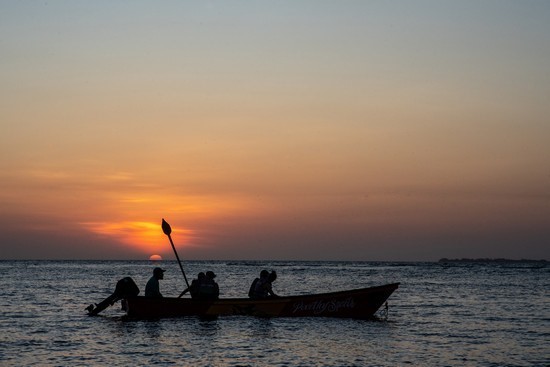
A sunset bird-watching tour on the Caribbean Sea near Rincón del Mar, Colombia, on January 29, 2023.
I emerged from our talks with a culinary treasure map that would lead me on a quest from beachside grills to a palm-shaded islet to a green thatch-roofed house, the whole journey flavored with coconut, garlic, cassava, cheese and of course, sesame.
Respect the octopusAs the scent of grilling food and the distinctive rasp of Espinosa’s voice drifted from the beach, I knew I had arrived at her workshop at the Hostal Arrecife in Rincón del Mar just in time.
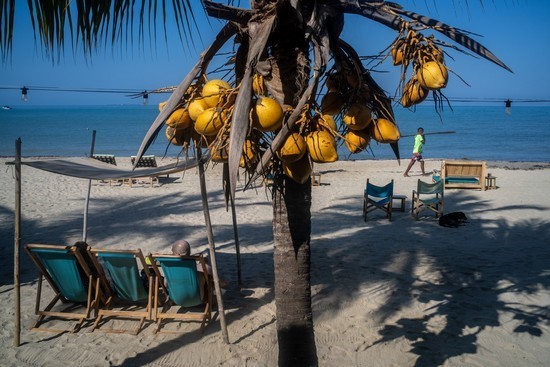
The beach at Dos Aguas, an eco-resort in Rincón del Mar, Colombia, on January 29, 2023.
“Note that the octopus looks complete,” she was saying in Spanish to several onlookers on a shaded patch of sand that had become her seaside demo kitchen. I recognized her voice from video footage, though I had never met her in person. A moment later, I was there next to her and the octopus. “If you remove the tentacles,” she went on, “you massacre it.”
Considering the animal was clearly deceased, I wondered what I was missing, but the mystery did not last. Bowing toward the octopus and preaching deep respect for one’s ingredients, she said, “We have to pay homage to them. We can’t massacre them by stripping away their flavor.” Her fervor bordered on the religious.
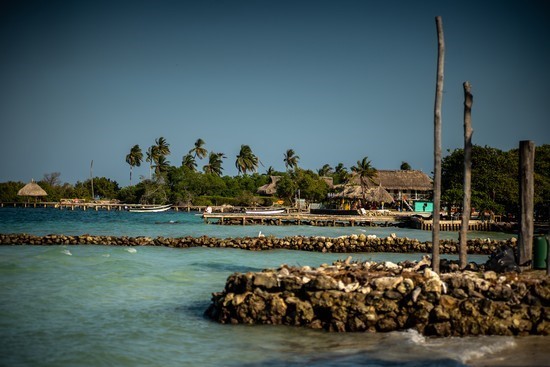
Tintipán, an island about 40 minutes off the Colombian coast, on January 29, 2023.
So during our first one-on-one conversation, when the group was on break, I was not surprised to hear Espinosa recall the flavors of her youth with the sort of reverence and pacing typically reserved for mantras. “Ají dulce … yuca … ñame,” she intoned, conjuring visions of chiles, cassava and yams. She cut an almost monastic figure in her white-on-cream ensemble against the lime-green hammock that enveloped her.
I happened to have just tasted some local yuca in a coconut cheesecake — a salty-sweet revelation. Yet as Espinosa continued to tell me about her most beloved local foods, few others sounded familiar, and most sounded magical — none more so than ajonjolí. The name alone got me, but so did the idea of toasted sesame seeds imbued with an intoxicatingly rich tropical terroir and hand-ground into a paste in accordance with a “culinary tradition that’s being lost in cities but that can still be felt in rural zones,” Espinosa said.
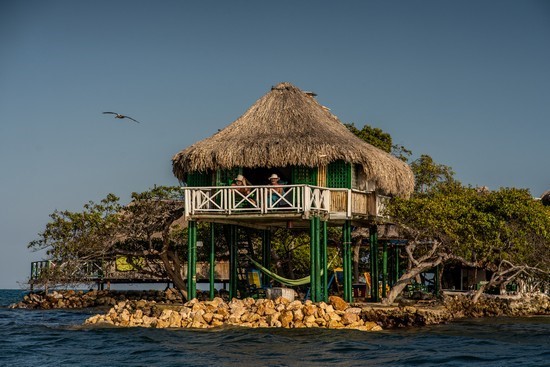
A house on the shore of Tintipán, an island about 40 minutes off the Colombian coast, on January 29, 2023.
I got an unexpected preview a few hours later at the Dos Aguas Lodge, the beachside eco-resort where I’d booked my stay and local excursions. After a hallucinatory double feature — sunset bird-watching alongside an island that was submerged save for a few protruding treetops, then a swim in a bioluminescent lagoon — I returned ravenous. And there on the kitchen’s chalkboard was the fabled ajonjolí, in the form of a housemade sesame-infused ice cream paired with a Colombian cacao brownie.
Although this clearly wasn’t the pure, unadulterated sesame paste in my marching orders, it was bedtime snacking perfection and an interesting conversation starter with the Dos Aguas co-founder Dania Bianuni, whom I had asked about the dish. She explained that as relative newcomers to Rincón del Mar who hoped not to infringe on the community’s traditional restaurants, the hotel staff generally stuck to unorthodox preparations of the local staples.
The island of sizzling arepasThe next day, my culinary map dispatched me to the palm-shaded shores of Isla Tintipán — about 40 minutes off the coast — in search of arepas de huevo, a deep-fried, egg-filled dough pouch that’s practically synonymous with Colombian Caribbean cuisine.
Every boat driver would know a restaurant called Rocio’s place, I was assured, even those who still referred to it by the owner’s ancestors’ names because it had been in the family for generations, albeit on the tiny neighboring island of Santa Cruz del Islote.
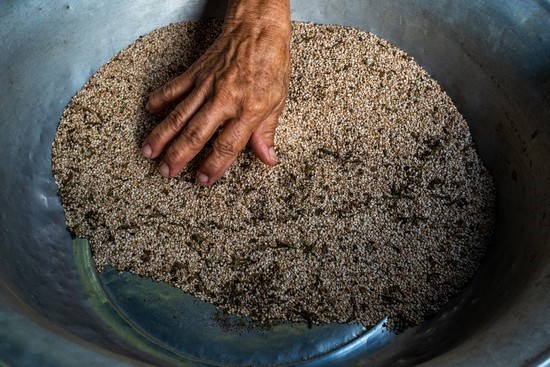
Although Tintipán was distractingly beautiful — with aquamarine waters lapping at white-sand beaches and lush, navigable mangroves cutting inland — I remained single-minded in my quest for the Platonic ideal of an arepa de huevo. Fresh from the sizzling oil, perfectly spongy and extra plump, my lunch boldly defied the waiter’s words as he placed it on the table: “Su arepita!” (Your little arepa!) I sprinkled on some sea salt and drizzled on some suero (a whey-based condiment along the lines of labneh, but thinner and generally tangier), then I ate like no one was watching, because no one was. There were far more interesting things to see on the beach, where crowds of Colombian day-trippers were dancing to competing rhythms that reverberated from portable speakers.
Finishing with a coconut caramel, a bite-size dessert that’s satisfyingly rich and chewy but not cloyingly sweet, I headed back to the mainland, where I suddenly wished I could book the arepa-making class that Dos Aguas offered at the home of a local expert. But the open road called, as did my driver to confirm an early pickup the next morning.
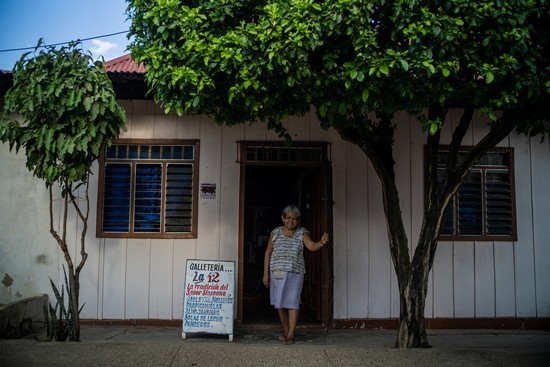
Magalis Rodríguez, the fourth-generation confectioner who owns Galletería la 12 in San Luis de Sincé, Colombia, on January 30, 2023.
In search of a ‘good hand’We zigzagged deep into the Caribbean savanna, about three hours southeast of Rincón del Mar, to San Luis de Sincé, a small town with at least four big loves: Espinosa, whose family hails from there; author Gabriel García Márquez, who spent part of his childhood there; clarinetist and composer Juan Madera Castro, who was born there; and ajonjolí — not necessarily in that order.
Espinosa’s family seat still holds pride of place on the central plaza, as does a childhood home of García Márquez, whose devotees sometimes claim San Luis de Sincé inspired the fictional town of Macondo in the novel “One Hundred Years of Solitude.” The Casa de la Cultura de Sincé has a fascinating installation on the author, as well as on Madera, whose most famous composition, “La Pollera Colorá,” is basically the unofficial national anthem. But much as I enjoyed my immersion into local lore, I had some eating to do.
Espinosa had instructed me to scout out private homes for ajonjolí, an experience that reminded me of buying the fermented corn drink chicha in the Peruvian Andes at houses with telltale little flags. But in Sincé, the big, bright “Ajonjolí here!” signs along the roads made my quest even easier.
The thatch-roofed house I chose had parakeet green walls, inside and out. Maybe García Márquez had gotten to me, but the magic realism vibes were tough to ignore — especially when I remembered something I had heard about ajonjolí vendors: Only those who had been blessed with a “good hand” could grind the local sesame into a proper paste. The woman at the front door assured me she descended from a long line of good hands, and the moment I scooped a sample out of a repurposed instant-coffee jar, I was a believer.
A bowl of pure blissLuckily, I had time to digest on the drive to Galeras, a leafy, livestock-breeding town only about 24km to the southeast but still 45 minutes away on the muddy savanna roads. Next stop on the map was Restaurante Donde Mingo, where I was told not to miss the house mote, a yam-and-cheese soup that alone would have been worth the trip. Using a cream of various Caribbean yams for a base, the chef, Domingo “Mingo” Ramos, had added copious cheese, suero, local greens and a divinely inspired sauté of garlic and onion.
Taking a breather halfway through my bowl in hopes of being able to fit more in, I wandered to one end of the thatch-roofed, open-sided dining room, where a traditional piper, three drummers and a wild man on the maracones (picture XXL maracas) had whipped the lunch crowd into a singalong frenzy.
I danced until I felt I had made enough room to continue with the next courses: garlicky eggplant, coconut rice and herbaceous aguardiente (direct translation: firewater, but more like a rustic brandy). No room for dessert, alas, but I took solace in the knowledge that I would be back someday for the city’s concurrent January festivals: one, a celebration of all treats carob-based, and the other, the UNESCO-listed Cuadros Vivos — or “living paintings — in which the locals themselves, elaborately costumed, made up and staged, become the open-air art installations.
As I contemplated my jar of ajonjolí and the rest of the Sincé sweets my driver and I would savor as our journey came to an end, my thoughts returned to that first encounter with Espinosa back in Rincón del Mar: You have to respect the ingredients, she had said. My short time in the place that had nurtured her renowned cooking had been packed with flavors, but to fully respect all those ingredients, I realized, I would need to return with far more time.
Read more Travel
Jordan News
Leonor Espinosa — who had just been crowned the 2022 Best Female Chef by World’s 50 Best, an influential ranking group owned by a British media giant — suggested the sesame paste known locally as pasta de ajonjolí was one of many delicacies in the area that transcend mere taste, and soon I would know why.

Food and drinks served at El Canto de la Caracola, a restaurant in Rincón del Mar, Colombia, on January 29, 2023.
I had gone to Rincón del Mar, a three-hour drive southwest of Cartagena, to meet Espinosa on her home turf. Granted, Espinosa now lives in Bogotá, where her restaurant, Leo, has drawn accolades. But her roots trace back to the country’s Caribbean region, where she spent most of her childhood.
Now she returns regularly to lead laboratorios: workshops sponsored by her foundation, FUNLEO, that bring together cooks from often forgotten and underresourced communities to prepare local dishes while cataloging and preserving as many traditional ingredients, recipes and techniques as possible.
I was not there to participate (the workshops are open only to the invited community chefs) but to ask Espinosa for some direction. Since her widely reported ascent to the gastronomic throne, I realized how little I knew about where she came from: part of the Caribbean tucked away from the well-trodden Cartagena-Barranquilla corridor. So I reached out to the foundation, and after chatting with its director, I hatched a plan: to meet up with the chef during a workshop in the area, get her local insights, then use them to spend a few days exploring and eating.

A sunset bird-watching tour on the Caribbean Sea near Rincón del Mar, Colombia, on January 29, 2023.
I emerged from our talks with a culinary treasure map that would lead me on a quest from beachside grills to a palm-shaded islet to a green thatch-roofed house, the whole journey flavored with coconut, garlic, cassava, cheese and of course, sesame.
Respect the octopusAs the scent of grilling food and the distinctive rasp of Espinosa’s voice drifted from the beach, I knew I had arrived at her workshop at the Hostal Arrecife in Rincón del Mar just in time.

The beach at Dos Aguas, an eco-resort in Rincón del Mar, Colombia, on January 29, 2023.
“Note that the octopus looks complete,” she was saying in Spanish to several onlookers on a shaded patch of sand that had become her seaside demo kitchen. I recognized her voice from video footage, though I had never met her in person. A moment later, I was there next to her and the octopus. “If you remove the tentacles,” she went on, “you massacre it.”
Considering the animal was clearly deceased, I wondered what I was missing, but the mystery did not last. Bowing toward the octopus and preaching deep respect for one’s ingredients, she said, “We have to pay homage to them. We can’t massacre them by stripping away their flavor.” Her fervor bordered on the religious.

Tintipán, an island about 40 minutes off the Colombian coast, on January 29, 2023.
So during our first one-on-one conversation, when the group was on break, I was not surprised to hear Espinosa recall the flavors of her youth with the sort of reverence and pacing typically reserved for mantras. “Ají dulce … yuca … ñame,” she intoned, conjuring visions of chiles, cassava and yams. She cut an almost monastic figure in her white-on-cream ensemble against the lime-green hammock that enveloped her.
I happened to have just tasted some local yuca in a coconut cheesecake — a salty-sweet revelation. Yet as Espinosa continued to tell me about her most beloved local foods, few others sounded familiar, and most sounded magical — none more so than ajonjolí. The name alone got me, but so did the idea of toasted sesame seeds imbued with an intoxicatingly rich tropical terroir and hand-ground into a paste in accordance with a “culinary tradition that’s being lost in cities but that can still be felt in rural zones,” Espinosa said.

A house on the shore of Tintipán, an island about 40 minutes off the Colombian coast, on January 29, 2023.
I got an unexpected preview a few hours later at the Dos Aguas Lodge, the beachside eco-resort where I’d booked my stay and local excursions. After a hallucinatory double feature — sunset bird-watching alongside an island that was submerged save for a few protruding treetops, then a swim in a bioluminescent lagoon — I returned ravenous. And there on the kitchen’s chalkboard was the fabled ajonjolí, in the form of a housemade sesame-infused ice cream paired with a Colombian cacao brownie.
Although this clearly wasn’t the pure, unadulterated sesame paste in my marching orders, it was bedtime snacking perfection and an interesting conversation starter with the Dos Aguas co-founder Dania Bianuni, whom I had asked about the dish. She explained that as relative newcomers to Rincón del Mar who hoped not to infringe on the community’s traditional restaurants, the hotel staff generally stuck to unorthodox preparations of the local staples.
The island of sizzling arepasThe next day, my culinary map dispatched me to the palm-shaded shores of Isla Tintipán — about 40 minutes off the coast — in search of arepas de huevo, a deep-fried, egg-filled dough pouch that’s practically synonymous with Colombian Caribbean cuisine.
Every boat driver would know a restaurant called Rocio’s place, I was assured, even those who still referred to it by the owner’s ancestors’ names because it had been in the family for generations, albeit on the tiny neighboring island of Santa Cruz del Islote.

Although Tintipán was distractingly beautiful — with aquamarine waters lapping at white-sand beaches and lush, navigable mangroves cutting inland — I remained single-minded in my quest for the Platonic ideal of an arepa de huevo. Fresh from the sizzling oil, perfectly spongy and extra plump, my lunch boldly defied the waiter’s words as he placed it on the table: “Su arepita!” (Your little arepa!) I sprinkled on some sea salt and drizzled on some suero (a whey-based condiment along the lines of labneh, but thinner and generally tangier), then I ate like no one was watching, because no one was. There were far more interesting things to see on the beach, where crowds of Colombian day-trippers were dancing to competing rhythms that reverberated from portable speakers.
Finishing with a coconut caramel, a bite-size dessert that’s satisfyingly rich and chewy but not cloyingly sweet, I headed back to the mainland, where I suddenly wished I could book the arepa-making class that Dos Aguas offered at the home of a local expert. But the open road called, as did my driver to confirm an early pickup the next morning.

Magalis Rodríguez, the fourth-generation confectioner who owns Galletería la 12 in San Luis de Sincé, Colombia, on January 30, 2023.
In search of a ‘good hand’We zigzagged deep into the Caribbean savanna, about three hours southeast of Rincón del Mar, to San Luis de Sincé, a small town with at least four big loves: Espinosa, whose family hails from there; author Gabriel García Márquez, who spent part of his childhood there; clarinetist and composer Juan Madera Castro, who was born there; and ajonjolí — not necessarily in that order.
Espinosa’s family seat still holds pride of place on the central plaza, as does a childhood home of García Márquez, whose devotees sometimes claim San Luis de Sincé inspired the fictional town of Macondo in the novel “One Hundred Years of Solitude.” The Casa de la Cultura de Sincé has a fascinating installation on the author, as well as on Madera, whose most famous composition, “La Pollera Colorá,” is basically the unofficial national anthem. But much as I enjoyed my immersion into local lore, I had some eating to do.
Espinosa had instructed me to scout out private homes for ajonjolí, an experience that reminded me of buying the fermented corn drink chicha in the Peruvian Andes at houses with telltale little flags. But in Sincé, the big, bright “Ajonjolí here!” signs along the roads made my quest even easier.
The thatch-roofed house I chose had parakeet green walls, inside and out. Maybe García Márquez had gotten to me, but the magic realism vibes were tough to ignore — especially when I remembered something I had heard about ajonjolí vendors: Only those who had been blessed with a “good hand” could grind the local sesame into a proper paste. The woman at the front door assured me she descended from a long line of good hands, and the moment I scooped a sample out of a repurposed instant-coffee jar, I was a believer.
A bowl of pure blissLuckily, I had time to digest on the drive to Galeras, a leafy, livestock-breeding town only about 24km to the southeast but still 45 minutes away on the muddy savanna roads. Next stop on the map was Restaurante Donde Mingo, where I was told not to miss the house mote, a yam-and-cheese soup that alone would have been worth the trip. Using a cream of various Caribbean yams for a base, the chef, Domingo “Mingo” Ramos, had added copious cheese, suero, local greens and a divinely inspired sauté of garlic and onion.
Taking a breather halfway through my bowl in hopes of being able to fit more in, I wandered to one end of the thatch-roofed, open-sided dining room, where a traditional piper, three drummers and a wild man on the maracones (picture XXL maracas) had whipped the lunch crowd into a singalong frenzy.
I danced until I felt I had made enough room to continue with the next courses: garlicky eggplant, coconut rice and herbaceous aguardiente (direct translation: firewater, but more like a rustic brandy). No room for dessert, alas, but I took solace in the knowledge that I would be back someday for the city’s concurrent January festivals: one, a celebration of all treats carob-based, and the other, the UNESCO-listed Cuadros Vivos — or “living paintings — in which the locals themselves, elaborately costumed, made up and staged, become the open-air art installations.
As I contemplated my jar of ajonjolí and the rest of the Sincé sweets my driver and I would savor as our journey came to an end, my thoughts returned to that first encounter with Espinosa back in Rincón del Mar: You have to respect the ingredients, she had said. My short time in the place that had nurtured her renowned cooking had been packed with flavors, but to fully respect all those ingredients, I realized, I would need to return with far more time.
Read more Travel
Jordan News


